1997 CADILLAC ELDORADO check engine
[x] Cancel search: check enginePage 223 of 361
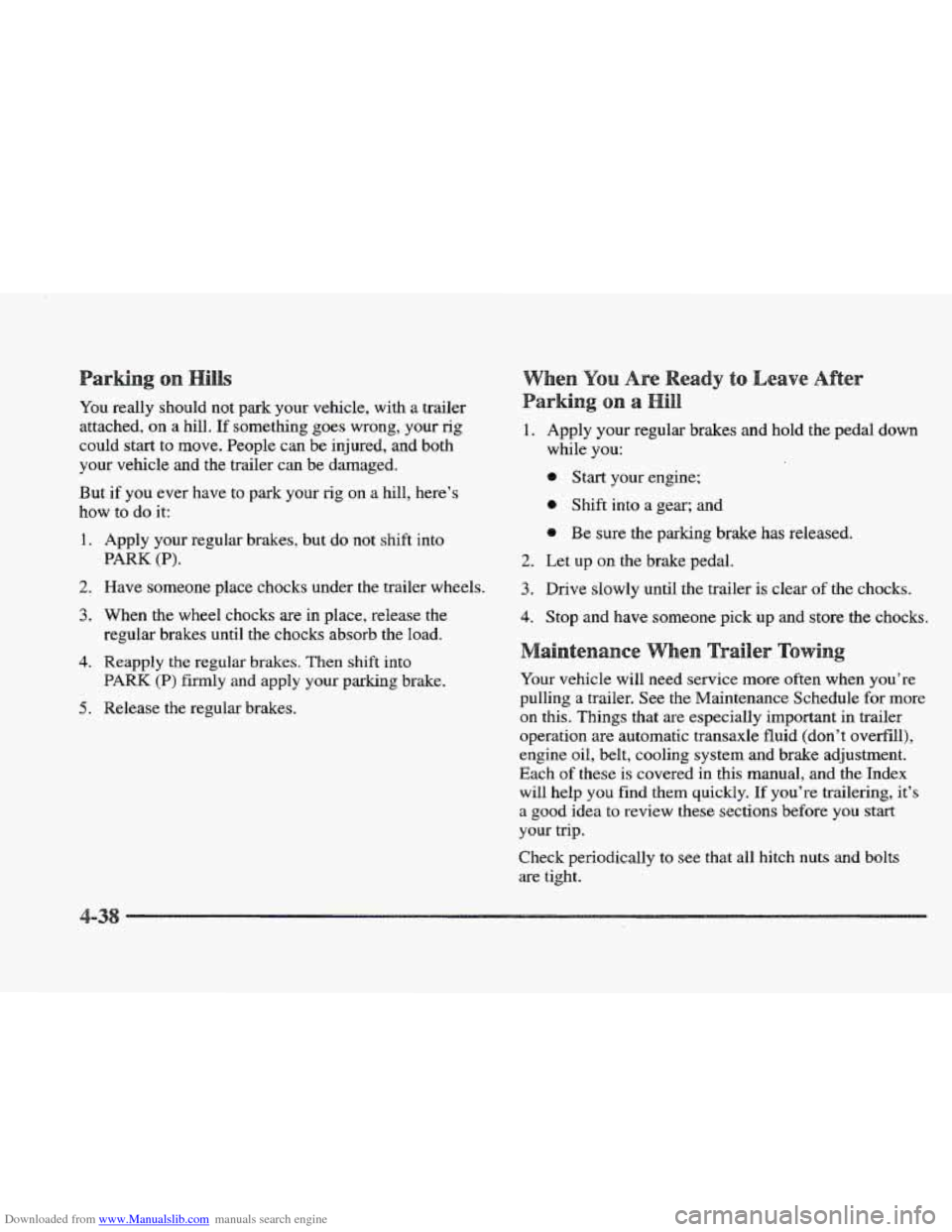
Downloaded from www.Manualslib.com manuals search engine You really should not park your vehicle, with a trailer
attached,
on a hill. If something goes wrong, your rig
could start
to move. People can be injured, and both
your vehicle and the trailer can be damaged.
But if
you ever have to park your rig on a hill, here’s
how to do it:
1. Apply your regular brakes, but do not shift into
PARK (P).
2. Have someone place chocks under the trailer wheels.
3. When the wheel chocks are in place, release the
regular brakes until
the chocks absorb the load.
PARK (P) firmly and apply your parking brake.
4. Reapply the regular brakes. Then shift into
Release the regular brakes.
1. Apply your regular brakes and hold the pedal down
while you:
Start your engine;
e Shift into a gear; and
Be sure the parking brake has released.
2. Let up on the brake pedal.
3. Drive slowly until the trailer is clear of the chocks.
4. Stop and have someone pick up and store the chocks.
Your vehicle will need service
more often when you’re
pulling
a trailer. See the Maintenance Schedule for more
on this. Things that are especially important in trailer
operation are automatic transaxle fluid (don’t overfill),
engine oil, belt, cooling system and brake adjustment.
Each of these is covered in this manual, and
the Index
will help
you find them quickly. If you’re trailering, it’s
a good idea to review these sections before you start
your trip.
Check periodically to see that all hitch nuts
and bolts
are tight.
Page 229 of 361
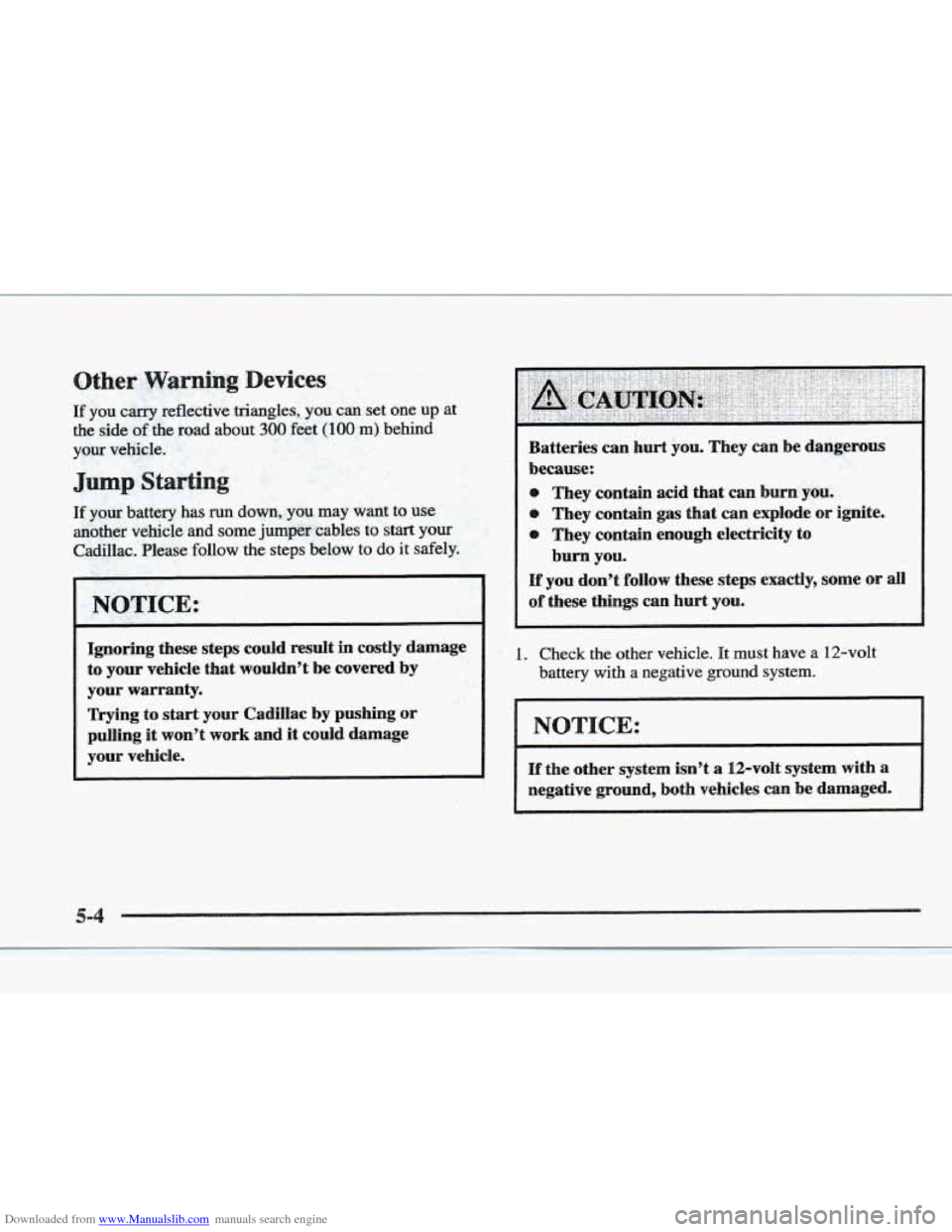
Downloaded from www.Manualslib.com manuals search engine If you carry. reflective .triangles, you can set one up at
the- side of the road about 300 feet (100 rn) behind
your vehiicle. c .&. ., . .
Jump Starting . ’
, .,-; b: .; k?,. .u ~,~ & - - 3 a- P
If your battery has run down, .you may want to use
another vehicle and
some jumper cables to start your
Cadilkc. Please follow the steps below to do it safely.
I NO~TICE:
Ignoring these steps could result in costly damage
to your vehicle that wouldn’t be covered by
your warranty.
Trying
to start your Cadillac by pushing or
pulling it won’t work and it could damage
your vehicle. Batteries
can hurt
you. They can be dangerous
because:
@ They contain acid that can bum’.you.,
e They contain gas that can explode or ignite.
They contain, enough electricity
to
burn you.
If you don’t follow these steps exactly, some or all
of these things can hurt you.
1. Check the other vehicle. It must have a 12-volt
battery with a negative ground system.
If the other system isn’t a 12-volt system with a
negative
ground, both vehicles can be damaged.
Page 231 of 361
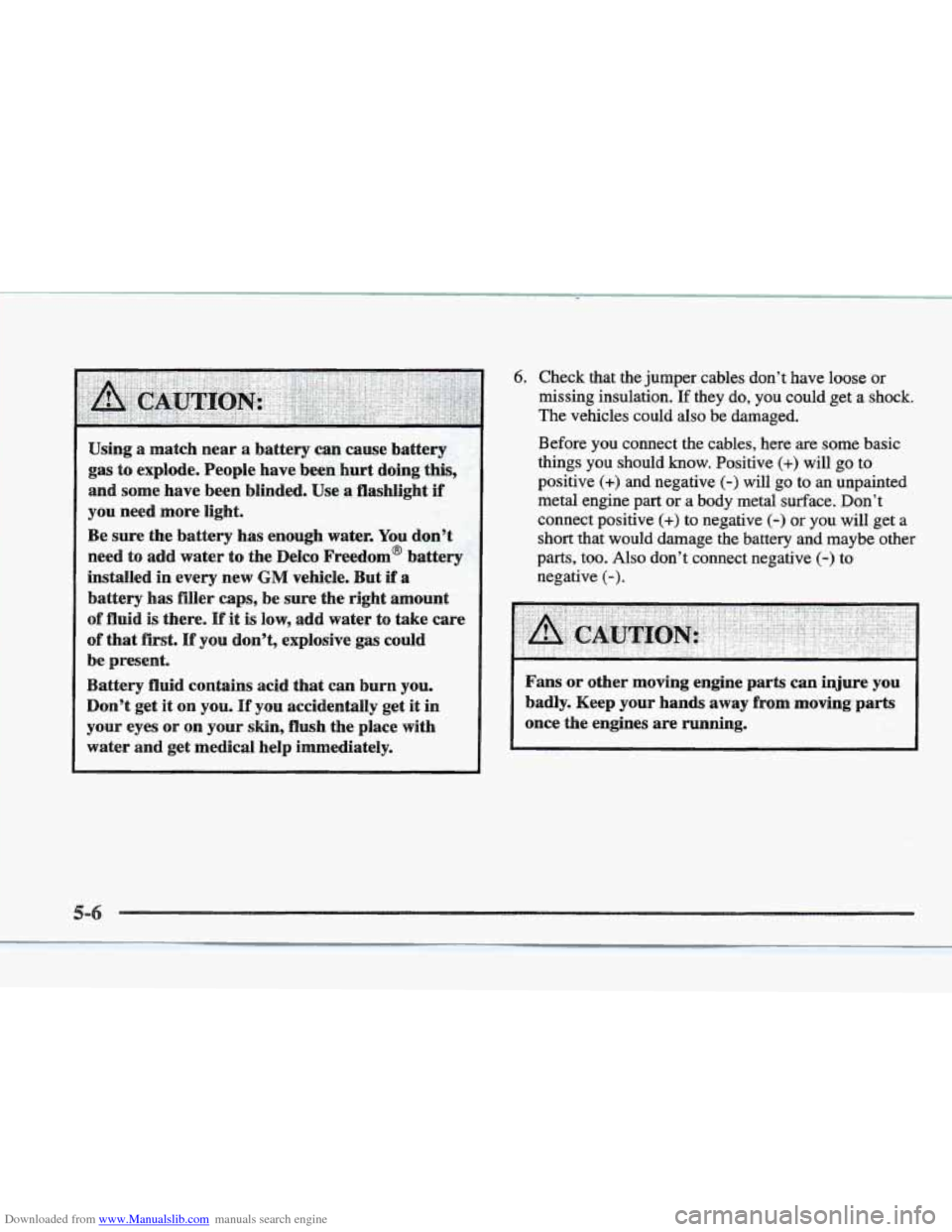
Downloaded from www.Manualslib.com manuals search engine Using a match near a battery can cause battery
gas to explode. People have been hurt doing this,
and some have been blinded. Use a flashlight if
you need more light.
Be sure the battery has enough water. You don’t
need
to add water to the Delco Freedom@ battery.
installed in every new
GM vehicle. But if a
battery has filler caps, be sure the right amount
of fluid is there. If it is IOW, add water to take care
of that first. If you don’t, explosive gas could
be present.
Battery fluid contains acid that
can burn you.
Don’t get it on
you. If you accidentally get it in
your eyes or on your skin, flush the place with
water
and get medical help immediately.
6. Check that the jumper cables don’t have loose or
missing insulation. If they do, you could get a shock.
The vehicles could
also be damaged.
Before
you connect the cables, here are some basic
things
you should know. Positive (+) will go to
positive
(+) and negative (-) will go to an unpainted
metal engine
part or a body metal surface. Don’t
connect positive
(+) to negative (-) or you will get a
short that would damage the battery and. maybe other
parts, too. Also don’t connect negative (-) to
negative
(-).
Fans or other moving engine parts can injure you
badly. Keep your hands away
from moving parts
once the engines are running.
Page 245 of 361
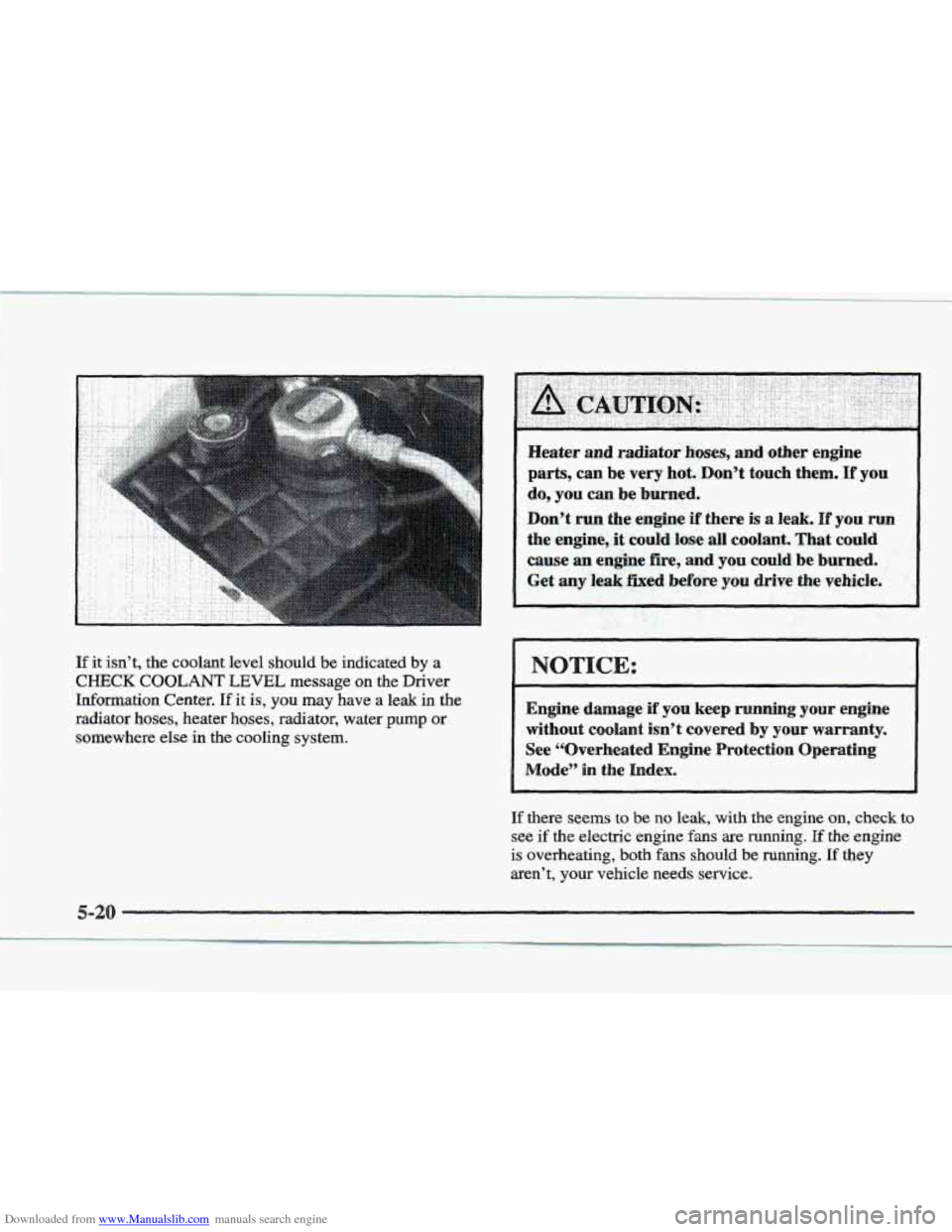
Downloaded from www.Manualslib.com manuals search engine If it isn’t, the coolant level should be indicated by a
CHECK COOLANT LEVEL message on the Driver
Information Center.
If it is, you may have a leak in the
radiator hoses, heater hoses, radiator, water
pump or
somewhere else in
the cooling system.
Heater and radiatoi hoses, and.other engine
parts, can be very hot. Don’t touch them. If you
do, you can be burned.
.Don’t run sthe engine if-there is a leak. If you
the engine,.+it could loge all coolant. That could
cause an engine fire, and sou could be burned.
Get any leak Pled before you drive ,. the vehicle. ’’-
NOTICE:
Engine damage if you keep running your engine
without coolant isn’t covered by your warranty.
See “Overheated Engine Protection Operating
Mode” in the Index.
If there seems to be no leak, with the engine on, check to
see if the electric engine fans are running. If the engine
is overheating, both fans should be running. If they
aren’t, your vehicle needs service.
Page 250 of 361
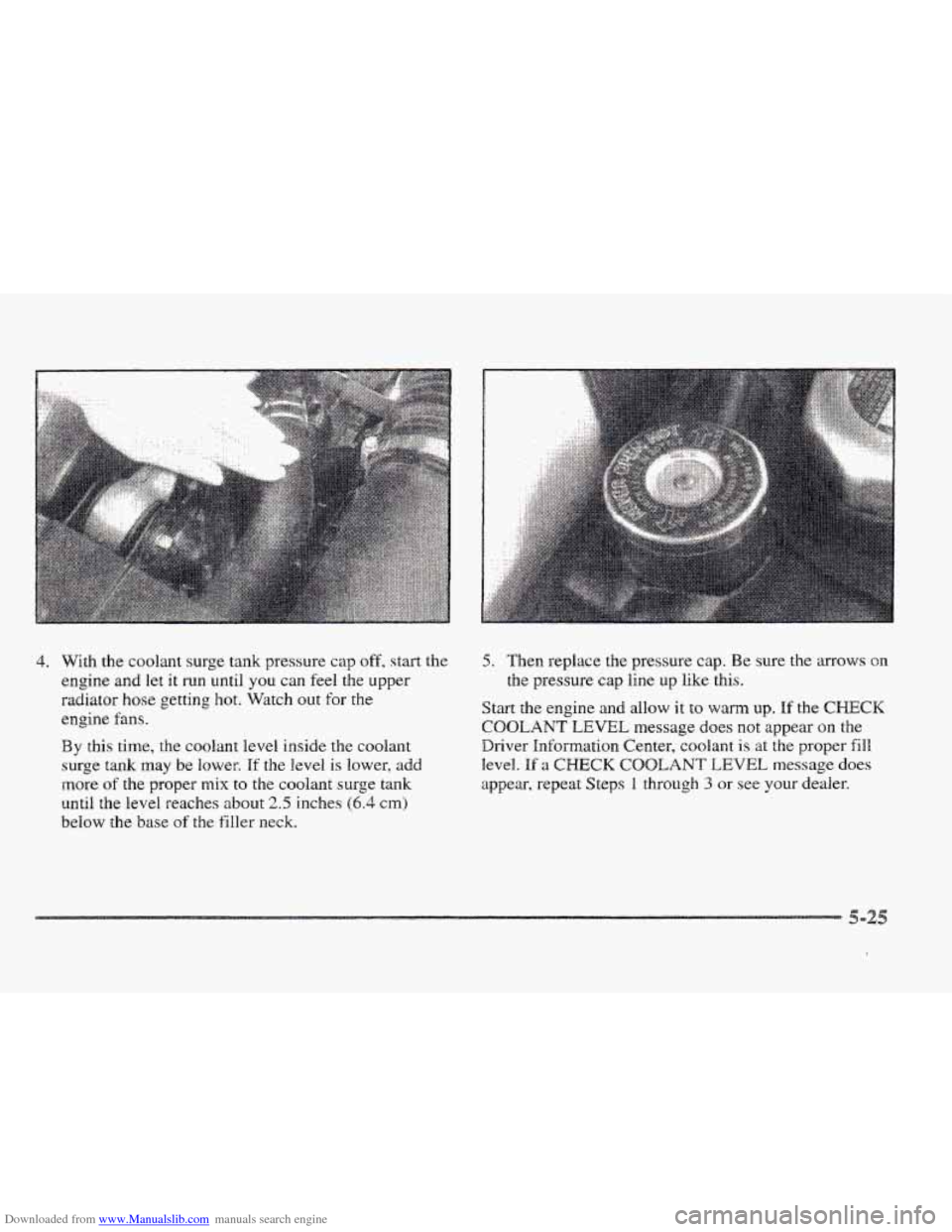
Downloaded from www.Manualslib.com manuals search engine 4. With the coolant surge tank pressure cap off, start the
engine and let
it run until you can feel the upper
radiator hose getting hot. Watch out
for the
engine fans.
By this time, the coolant level inside the coolant
surge tank
may be lower. If the level is lower, add
more of the proper mix to the coolant surge tank
until the level reaches about 2.5 inches (6.4 cm)
below
the base of the filler neck.
5. Then replace the pressure cap. Be sure the ~QWS on
Start the engine and allow it to warm up. If the CHECK
COOLANT LEVEL message does not appear on the
Driver Infomation Center, coolant is at the proper fill
level. If a CHECK COOLANT LEVEL message does
appear, repeat Steps 1 through 3 or see your dealer.
the pressure cap line up like this.
-2
Page 261 of 361
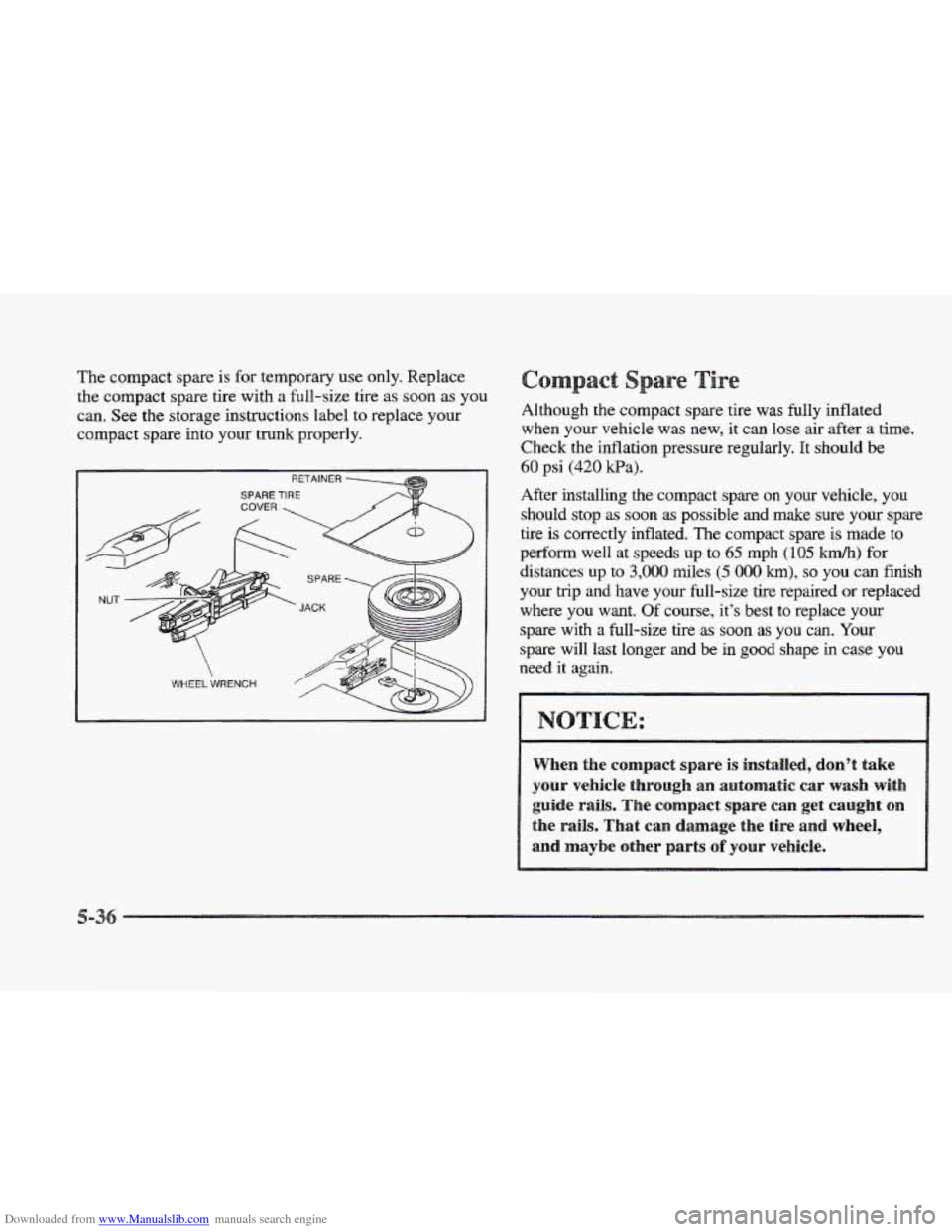
Downloaded from www.Manualslib.com manuals search engine The compact spare is for temporary use only. Replace
the compact spare tire with
a full-size tire as soon as you
can. See the storage instructions Babel to replace your
compact spare into your
trunk properly.
c
Although the compact spare tire was fully inflated
when your vehicle
was new, it can lose air after a time.
Check the inflation pressure regularly. It should be
60 psi (420 Wa).
After installing the compact spare on your vehicle, you
should stop
as soon as possible and make sure your spare
tire is correctly inflated. The compact spare
is made to
perform well at speeds
up to 65 mph (105 km/h) for
distances
up to 3,000 miles (5 000 km), so you can finish
your
trip and have your full-size tire repaired or replaced
where you want.
Of course, it’s best to replace your
spare with
a full-size tire as soon as you can. Your
spare will last longer and be in good shape in case you
need it
again.
When the cornpact spare is installed, don’t take
your vehicl rough an automatic car wash with
the rails. That can damage the tire and wheel,
guide rails. compact spare can get caught on
sand maybe other parts of your vehicle.
Page 264 of 361
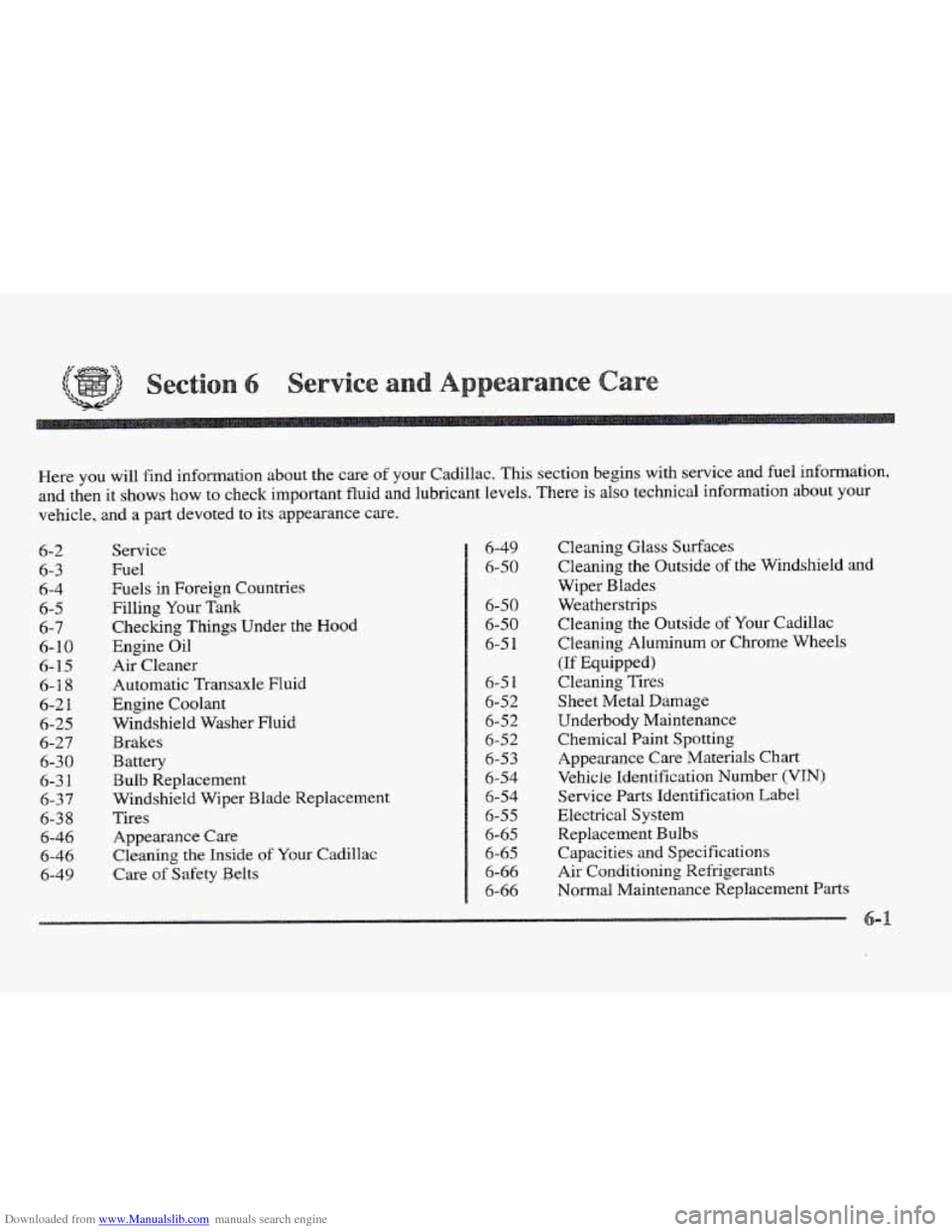
Downloaded from www.Manualslib.com manuals search engine Here you will find information about the care of your Cadillac. This section begins with service and fuel information,
and then
it shows how to check important fluid and lubricant levels. There is also technical information about your
vehicle, 2nd a part devoted to its appearance care.
6-2
6-3
6-4
6-5
6-7
6-10
6-
15
6-1 8
6-2 1
6-25
6-27
6-30
6-3
1
6-37
6-3 8
6-46
6-46
6-49
Service
Fuel
Fuels in Foreign Countries
Filling Your Tank
Checking Things Under the Hood
Engine Oil
Air Cleaner
Automatic Transaxle Fluid
Engine Coolant
Windshield Washer Fluid
Brakes
Battery
Bulb Replacement
Windshield Wiper Blade Replacement
Tires Appearance Care
Cleaning the Inside
of Your Cadillac
Care
of Safety Belts
4-49
6-50
6-50
6-50
6-5 1
6-5 1
6-52
6-52
6-52
6-53
6-54
6-54
6-55
6-65
6-65
6-66
6-66 Cleaning
Glass Surfaces
Cleaning the Outside
of the Windshield and
Wiper Blades
Weatherstrips Cleaning the Outside
of Your Cadillac
Cleaning Aluminum
or Chrome Wheels
(If Equipped)
Cleaning Tires
Sheet Metal
Damage
Underbody Maintenance
Chemical Paint Spotting
Appearance Care Materials Chart
Vehicle Identification Number
(VIN)
Service Parts Identification Label
Electrical System Replacement Bulbs
Capacities and Specifications
Air Conditioning Refrigerants
Normal Maintenance Replacement Parts
Page 266 of 361
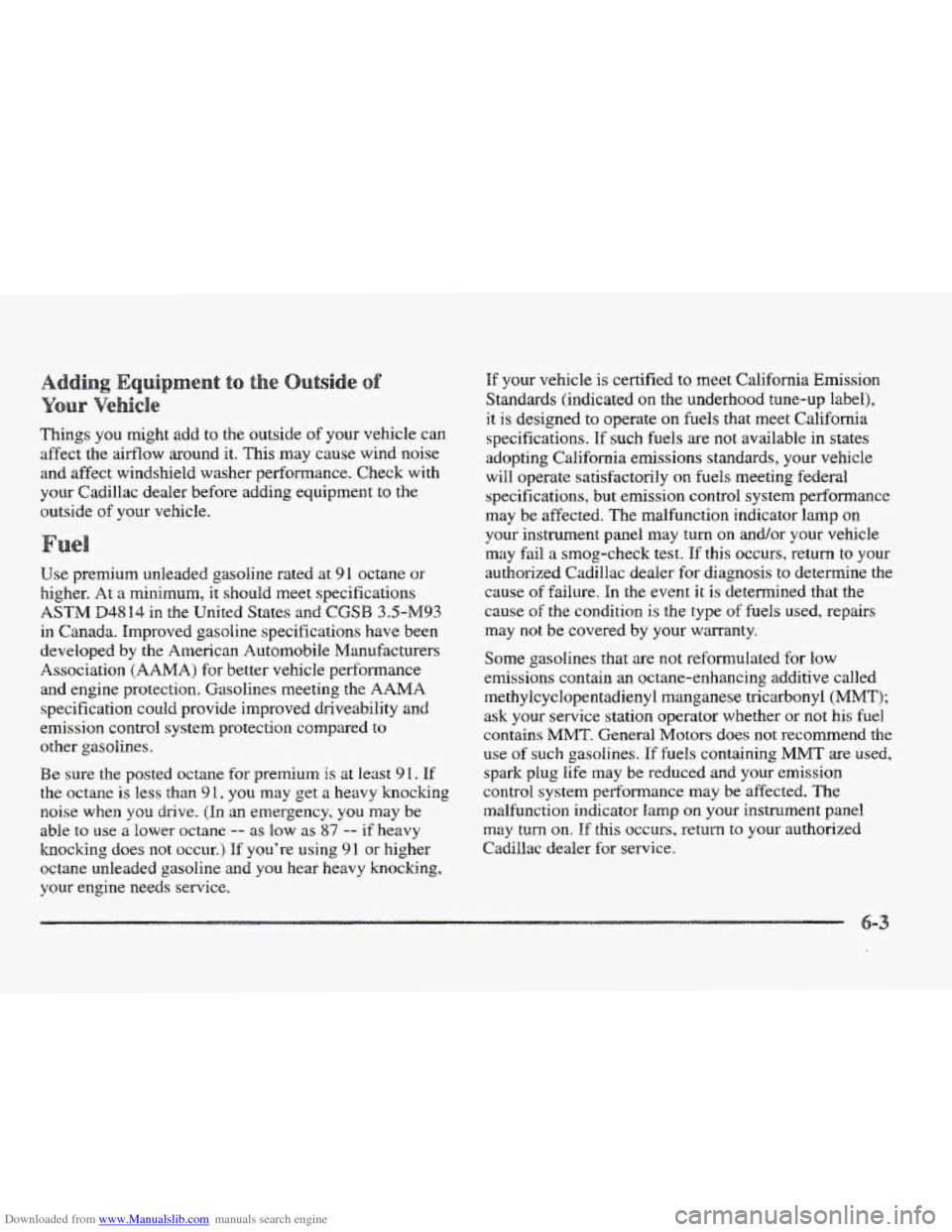
Downloaded from www.Manualslib.com manuals search engine Things you might add to the outside of your vehicle can
affect the airflow around
it. This may cause wind noise
and affect windshield washer performance. Check with
your Cadillac dealer before adding equipment to the
outside
of your vehicle.
Use premium unleaded gasoline rated at
9 1 octane or
higher. At a minimum, it should meet specifications
ASTM D4814 in the United States and CGSB 3.5-WI93
in Canada. Improved gasoline specifications have been
developed by the American Automobile Manufacturers
Association
(AAMA) for better vehicle performance
and engine protection. Cholines meeting the
AAMA
specification could provide improved driveability and
emission control system protection compared to
other gasolines.
Be sure the posted octane
for premium is at least 9 I. If
the octane is less than
91, you may get a heavy knockmg
noise when
you drive. (In an emergency, you may be
able
to use a lower octane -- as low as 87 -- if heavy
knocking does not occur.) If
you're using 91 or higher
octane unleaded gasoline
and you hear heavy knocking,
your engine needs service.
If your vehicle is certified to meet California Emission
Standards (indicated on
the underhood tune-up label),
it is designed to operate on fuels that meet California
specifications. If such
fuels are not available in states
adopting California emissions standards, your vehicle
will operate satisfactorily
on fuels meeting federal
specifications, but emission control system performance
may be affected. The malfunction indicator lamp on
your instrument panel
may turn on and/or your vehicle
may fail a smog-check test. If this occurs, return to your
authorized Cadillac dealer
for diagnosis to determine the
cause
of failure. In the event it is determined that the
cause
of the condition is the type of fuels used, repairs
may not be covered by your warranty.
Some gasolines that are not reformulated for low
emissions contain an octane-enhancing additive called
rnethylcyclopentadienyl manganese tricarbonyi
(MMT);
ask your service station operator whether or not his fuel
contains
MMT. General Motors does not recommend the
use of such gasolines. If fuels containing MMT are used,
spark plug life may be reduced and your emission
controa system performance may be affected. The
malfunction indicator
lamp on your instrument panel
may turn on. If this occurs, return to your authorized
Cadililac dealer fox service.